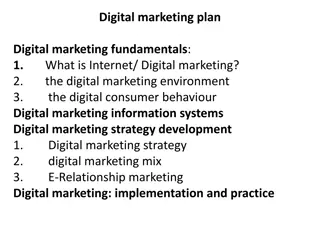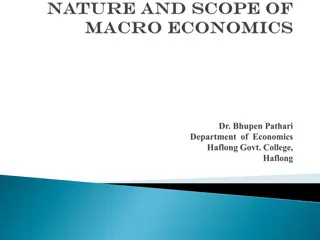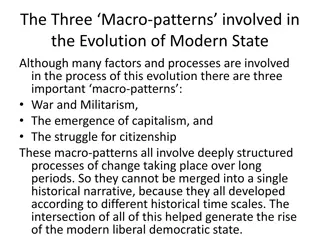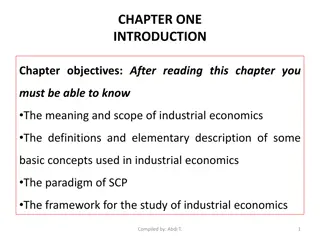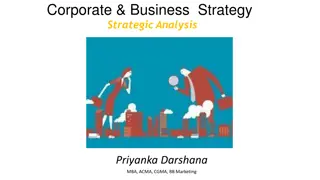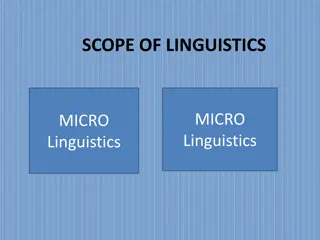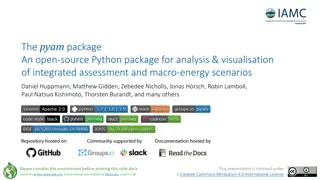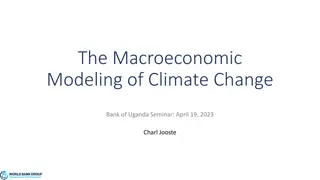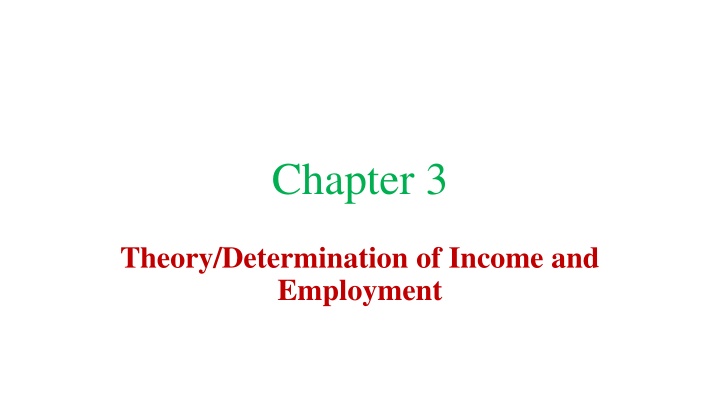
Theory of Income and Employment: Classical Perspective
Learn about the classical theory of income and employment, covering concepts like full employment, unemployment types, and the classical economists' perspective on market equilibrium and government intervention.
Download Presentation

Please find below an Image/Link to download the presentation.
The content on the website is provided AS IS for your information and personal use only. It may not be sold, licensed, or shared on other websites without obtaining consent from the author. If you encounter any issues during the download, it is possible that the publisher has removed the file from their server.
You are allowed to download the files provided on this website for personal or commercial use, subject to the condition that they are used lawfully. All files are the property of their respective owners.
The content on the website is provided AS IS for your information and personal use only. It may not be sold, licensed, or shared on other websites without obtaining consent from the author.
E N D
Presentation Transcript
Chapter 3 Theory/Determination of Income and Employment
KEY WORDS 1. Employment: A situation when a person is able and willing to take up a job and gets employed. 2. Full Employment: A situation where all those workers who are able and willing to work get employment. 3. Under Employment: A situation when people are engaged in jobs but they do not get these jobs according to their capabilities, efficiency and qualifications. 4. Unemployment: A situation when a person is willing to work but does not get opportunity to work.
5. Involuntary Unemployment: A situation when the workers are willing to work under any conditions and at any wage rate but they fail to get employment. 6. Voluntary Unemployment: When the economy offers employment opportunities to the workers, but they themselves are not willing to take up jobs because the employment conditions such as wage rate, location, promotional avenues, physical environment, attitude of the employer, etc., do not suit them. 7. Cyclical Unemployment: It is caused by slackness in business conditions. During depression, investment activities get discouraged. Contraction in business activities renders large numbers of workers unemployed. 8. Technological Unemployment: It is generally found in the advanced countries. The main cause of this unemployment is the introduction of the new technology.
9. Frictional Unemployment: It is a temporary unemployment which exists during the period of the transfer of labor from one occupation to another. 10. Structural Unemployment: it is the result of the backwardness and underdevelopment of an economy. 11. Disguised Unemployment: when more workers are engaged in a work than actually required to work, it is called disguised unemployment
Classical Theory of Income and Employment: The classical economist are those who believe in lasiz fair theory. Lasiz fair means non interference of government. Old classical economists like Adam Smith, Ricardo, J. B. Say, J. S. Mill, and Others, developed the classical theory of employment. This theory states that full employment is a normal feature of a capitalist economy. The classical theory of employment rules out the possibility of unemployment in a free market economy. The economy would always be in a full employment equilibrium.
Assumptions The classical theory of employment is based on the following assumptions: 1. The Say s law of market; 2. Flexibility of the interest rates; 3. Flexibility of the wage rates. According to Say s Law of Market, The supply creates its own demand . It is an automatic mechanism which establishes equilibrium between aggregate demand and aggregate supply. The implication of the classical system is that there will never be a possibility of over- production or under- production in the economy. During the Great Depression of 1930s, the Classical Theory of Employment failed miserably.
Prof. J. M. Keynes developed a new theory of employment in his book General Theory of Employment, Interest and Money published in 1936. Keynesian theory of employment is based on the concept of effective demand. Effective demand means the level of income where aggregate demand and aggregate supply are equal. Prof. J. M. Keynes used the approach of aggregate demand and aggregate supply for the determination of full employment equilibrium
Aggregate Demand: The total demand for goods and services in an economy in a year s time is called aggregate demand. It is expressed in terms of total expenditure of the community. Goods and services are demanded for two purposes- (1) Consumption, and (2) Investment. Consumption is of two types: private (household) consumption and public (government) consumption. Similarly, investment is also of two types: private (household) investment and public (government) investment. Aggregate Demand (AD) = Consumption Demand (C) + Investment Demand (I) AD = C + I Y = C + I
Aggregate Demand Schedule: The aggregate demand schedule can be drawn by aggregating- aggregate consumption (C) and aggregate investment (I) at different levels of income. Consumption depends on income (Y), propensity to consume (c) and many other factors. C = a + cY
60 Income Consumption IN SR 0 20 50 10 25 40 20 30 30 30 35 40 40 20 50 45 10 60 50 0 0 10 20 30 40 50 60
Aggregate Investment: It is of two types- autonomous investment and induced investment. Autonomous Investment: it is that expenditure on capital formation which is undertaken independently of the level of income. Induced Investment: it is expenditure both on fixed assets and on the stocks that are required if the economy is to be able to produce a bigger output as aggregate demand rises.
(SR 000 Crores) Income & Autonomous Investment 25 Income Investment 0 20 20 10 20 AUTONOMUS INVESTNET 15 20 20 30 20 10 40 20 5 50 20 60 20 0 0 10 20 30 40 50 60 INCOME
Aggregate demand schedule can be derived by adding consumption schedule and investment schedule. Income (Y) Consumption (C) Investment (I) Aggregate Demand (AD = C + I) 80 70 60 Consumption and Investment 0 20 20 40 50 10 25 20 45 40 20 30 20 50 30 30 35 20 55 20 40 40 20 60 10 50 45 20 65 60 50 20 70 0 0 10 20 30 40 50 60 National Income
Components of Aggregate Demand: There are four major components of aggregate demand- 1. Household consumption expenditure (C); 2. Government final consumption expenditure (G); 3. Private and public investment expenditure (I); and 4. Net export (X-M) Symbolically, AD = C + I + G + (X-M)
Aggregate Supply: It refers to the money value of all goods and services produced in a country in a year s time. It, in fact, refers to the national income of a country because it is the money value of all goods and services produced in a year s time. Aggregate Supply = Domestic Product = Total Factor Incomes = National Income Aggregate Supply (AS) = Consumption (C) + Saving (S) Y = C + S
Aggregate Supply (AS = C + S) Figure 80 Income (Y) Consumptio n (C) Savings (S) Aggregate Supply (AS = C + S) 70 60 Consumption and Saving 0 20 -20 0 50 10 25 -15 10 40 20 30 -10 20 30 30 35 -5 30 40 40 0 40 20 50 45 5 50 10 60 50 10 60 0 70 55 15 70 0 10 20 30 40 50 60 70 National Income
Determination of Equilibrium: Determination equilibrium of an economy can be studied by two approaches: As equality of aggregate demand and aggregate supply; and As equality of saving and investment. AS andAD Approach: Equilibrium level of income is determined where aggregate demand curve cuts aggregate supply. In other words, the level of income will be in equilibrium where aggregate demand is equal to aggregate supply.
AS and AD Approach: Income (Y) Aggregate Demand (AD= C+I) Aggregate Supply (AS= C+S) Income (Y) Aggregate Demand (AD= C+I) Aggregate Supply (AS= C+S) 120 AGGREGATE DEMAND AND AGGREGATE SUPPLY 0 40 0 100 10 45 10 20 50 20 80 30 55 30 40 60 40 60 50 65 50 60 70 60 40 70 75 70 20 80 80 80 90 85 90 0 100 90 100 0 10 20 30 40 50 60 70 80 90 100 National Income
If Aggregate Demand is not equal to Aggregate Supply: Aggregate Demand (AD) = Aggregate Supply (AS) If AD > AS If AD < AS Increase in employment of factor services Decrease in employment of factor services Increase in the level of output of goods and services Decrease in the level of output of goods and services Ultimately AD = AS Ultimately AD = AS
Alternative Approach to Equilibrium (Saving and Investment Approach): Since, AD is: Y = C + I, (1) And, AS is: Y = C + S, .. (2) By putting together equations (1) and (2), we get C + I = C + S Hence, I = S i. e., aggregate investment equals aggregate saving in the economy.
Diagrammatic Presentation: Saving (S) Investment (I) 40 Income (Y) Consumptio n (C) 20 25 30 35 40 45 50 55 60 65 70 Saving (S) Investment (I) 30 0 10 20 30 40 50 60 70 80 90 100 -20 -15 -10 -5 0 5 10 15 20 25 30 20 20 20 20 20 20 20 20 20 20 20 20 Saving & Investment 10 0 0 10 20 30 40 50 60 70 80 90 100 -10 -20 -30 National Income
Ex- ante Saving: Ex- ante saving is what the savers plan (or intend) to save at different levels of income in an economy. It is also known as intended saving or planned saving. Ex- post Saving: It refers to actual or realised saving in an economy during a year. Ex- ante Investment: Ex- ante investment is what the investors plan (or intend) to invest at different levels of income in an economy. It is also known as intended investment or planned investment. Ex- post Saving: It refers to actual or realised investment in an economy during a year.

